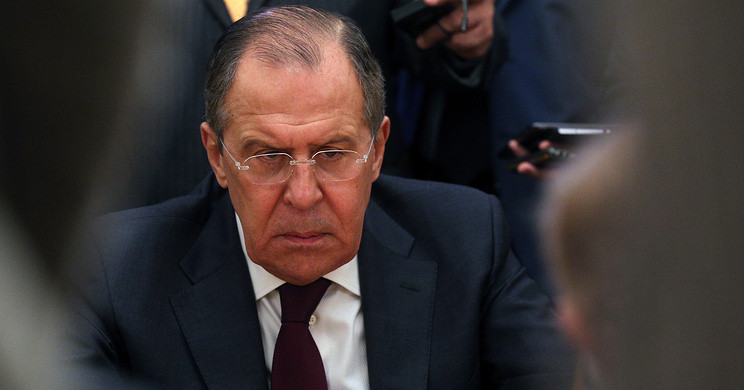Russian Foreign Minister Lavrov (pictured) clashes with US State Department over ceasefire arrangements in southwest Syria
LATEST
- Video: Frontline of Battle in Northeast Damascus
- Opposition Outlet Claims Kurdish Militia YPG “Black Prison”
The US and Russia had a public spat on Wednesday about their first de-escalation agreement in Syria’s conflict, only three days after it was implemented in the southwest of the country.
Donald Trump and Vladimir Putin heralded the deal, announced last Friday after their meeting at the G20 summit in Germany, as a breakthrough both for US-Russian relations and the 76-month crisis in Syria. The agreement has reduced violence in provinces along the borders with Jordan and the Israeli-occupied Golan Heights, although pro-Assad forces have continued shelling and have redeployed forces for offensives in southeast Syria and the Damascus suburbs.
But on Wednesday, the State Department exposed uncertainty about detailed implementation of the arrangements, amid Russia’s proclamations of a joint monitoring center and reports that Trump had accepted the deal without adequate consultation with the Pentagon.
Department spokesman Heather Nauert tried to pull back Russian Foreign Minister Sergei Lavrov’s declaration of a Russian-US-Jordanian center in Jordan’s capital Amman.
Mr. Lavrov likes to talk a lot and get out ahead, I think, of some of the negotiations that are underway. That is all still being worked out. We are a little over two days into the ceasefire in that part of Syria. We’re pleased with that. We think it’s holding fairly well at this point. In terms of who is doing what, when, where, how, some of those details are still being worked out.
It is unclear how a Russian-US-Jordanian center would sit alongside the US-led Military Operations Center in Amman, in which the Americans, UK, France, Jordan, and Saudi Arabia have provided intermittent assistance to the Syrian opposition and rebels during the conflict.
How can this lady know about what I like and what I don’t like? We are not acquainted with her….
A document, signed in Amman by Russian, US and Jordanian representatives includes a particular point registering a certain agreement on setting up this center.
While hailing the “terrific idea” of the agreement, Nauert betrayed uncertainty about the implementation, including which countries’ forces might oversee de-escalation on the ground:
This is something that I know is important to get to the position where there are monitors, and who those monitors will be I don’t know at this point. I know we have folks in the region. I know that our special envoy to Syria is actively engaged in these conversations, so I anticipate we’ll get that information in the in the near future.
Buzzfeed reported on Monday that “the US military has received no guidance on how to enforce the ceasefire”.
A military officer confirmed to Foreign Policy that the Pentagon and Central Command have very little information: “We’re getting to that level of understanding this week.”
Asked yesterday, “Do you think you might be able to provide a map or an outline of the specifics of the region, or just give more clarity?”, Nauert replied, “I’m not sure that we’ll be able to. That may be classified at this point. I can certainly look into that.”
Video: Frontline of Battle in Northeast Damascus
A Russian journalist reports from the frontline of the battle in Jobar in northeast Damascus, where regime forces and rebels have fought since 2012:
Russian journalist reports from the front line to Jobar's battle in #Damascus.
Report shows the destruction and fear amongst regime's forces pic.twitter.com/vkSoitUH2o— Husam Hezaber (@HusamHezaber) July 12, 2017
Pro-Assad forces, supported by intense aerial bombardment, have been trying to advance in the district, but have been unable to break rebel lines.
In the footage, a regime unit is pinned down by heavy fire, with severl casualties. Despite assistance from a T-72 tank, the platoon is forced to withdraw.
Opposition Outlet Claims Kurdish Militia YPG “Black Prison”
The opposition site al-Dorar claims that the Kurdish militia YPG is running a “black prison” in Aleppo Province.
In a video interview, former detainee Mahmoud Mohammed says he was held as a suspected Free Syrian Army fighter as he passed through the Kurdish center of Afrin:
I was taken to the black prison, which is a building inside which an olive press near the Raju area north of Aleppo [city]. It is impossible to live in, especially in winter when the rainwater pours on the prisoners.
“The number of prisoners in the militia’s jail estimated at more than 1500 people….Each 70 people were put in a no more than 4m × 4m room, provided with very bad food leading to poisoning cases amongst prisoners, no medicine for patients or injured, and bad and humiliating conditions of sleeping, eating and drinking.
Another former detainee at the Raju facility, Khaled Mohammed Kheir Obaid, claimed torture and beatings.

